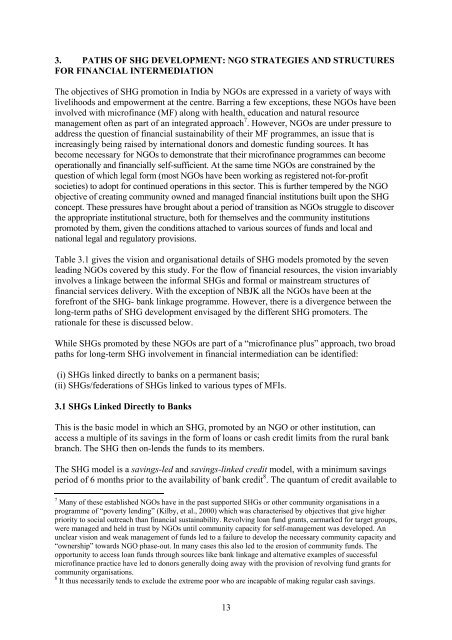Self-help Groups as Financial Intermediaries in India ... - Sa-Dhan
Self-help Groups as Financial Intermediaries in India ... - Sa-Dhan
Self-help Groups as Financial Intermediaries in India ... - Sa-Dhan
Create successful ePaper yourself
Turn your PDF publications into a flip-book with our unique Google optimized e-Paper software.
3. PATHS OF SHG DEVELOPMENT: NGO STRATEGIES AND STRUCTURESFOR FINANCIAL INTERMEDIATIONThe objectives of SHG promotion <strong>in</strong> <strong>India</strong> by NGOs are expressed <strong>in</strong> a variety of ways withlivelihoods and empowerment at the centre. Barr<strong>in</strong>g a few exceptions, these NGOs have been<strong>in</strong>volved with microf<strong>in</strong>ance (MF) along with health, education and natural resourcemanagement often <strong>as</strong> part of an <strong>in</strong>tegrated approach 7 . However, NGOs are under pressure toaddress the question of f<strong>in</strong>ancial susta<strong>in</strong>ability of their MF programmes, an issue that is<strong>in</strong>cre<strong>as</strong><strong>in</strong>gly be<strong>in</strong>g raised by <strong>in</strong>ternational donors and domestic fund<strong>in</strong>g sources. It h<strong>as</strong>become necessary for NGOs to demonstrate that their microf<strong>in</strong>ance programmes can becomeoperationally and f<strong>in</strong>ancially self-sufficient. At the same time NGOs are constra<strong>in</strong>ed by thequestion of which legal form (most NGOs have been work<strong>in</strong>g <strong>as</strong> registered not-for-profitsocieties) to adopt for cont<strong>in</strong>ued operations <strong>in</strong> this sector. This is further tempered by the NGOobjective of creat<strong>in</strong>g community owned and managed f<strong>in</strong>ancial <strong>in</strong>stitutions built upon the SHGconcept. These pressures have brought about a period of transition <strong>as</strong> NGOs struggle to discoverthe appropriate <strong>in</strong>stitutional structure, both for themselves and the community <strong>in</strong>stitutionspromoted by them, given the conditions attached to various sources of funds and local andnational legal and regulatory provisions.Table 3.1 gives the vision and organisational details of SHG models promoted by the sevenlead<strong>in</strong>g NGOs covered by this study. For the flow of f<strong>in</strong>ancial resources, the vision <strong>in</strong>variably<strong>in</strong>volves a l<strong>in</strong>kage between the <strong>in</strong>formal SHGs and formal or ma<strong>in</strong>stream structures off<strong>in</strong>ancial services delivery. With the exception of NBJK all the NGOs have been at theforefront of the SHG- bank l<strong>in</strong>kage programme. However, there is a divergence between thelong-term paths of SHG development envisaged by the different SHG promoters. Therationale for these is discussed below.While SHGs promoted by these NGOs are part of a “microf<strong>in</strong>ance plus” approach, two broadpaths for long-term SHG <strong>in</strong>volvement <strong>in</strong> f<strong>in</strong>ancial <strong>in</strong>termediation can be identified:(i) SHGs l<strong>in</strong>ked directly to banks on a permanent b<strong>as</strong>is;(ii) SHGs/federations of SHGs l<strong>in</strong>ked to various types of MFIs.3.1 SHGs L<strong>in</strong>ked Directly to BanksThis is the b<strong>as</strong>ic model <strong>in</strong> which an SHG, promoted by an NGO or other <strong>in</strong>stitution, canaccess a multiple of its sav<strong>in</strong>gs <strong>in</strong> the form of loans or c<strong>as</strong>h credit limits from the rural bankbranch. The SHG then on-lends the funds to its members.The SHG model is a sav<strong>in</strong>gs-led and sav<strong>in</strong>gs-l<strong>in</strong>ked credit model, with a m<strong>in</strong>imum sav<strong>in</strong>gsperiod of 6 months prior to the availability of bank credit 8 . The quantum of credit available to7 Many of these established NGOs have <strong>in</strong> the p<strong>as</strong>t supported SHGs or other community organisations <strong>in</strong> aprogramme of “poverty lend<strong>in</strong>g” (Kilby, et al., 2000) which w<strong>as</strong> characterised by objectives that give higherpriority to social outreach than f<strong>in</strong>ancial susta<strong>in</strong>ability. Revolv<strong>in</strong>g loan fund grants, earmarked for target groups,were managed and held <strong>in</strong> trust by NGOs until community capacity for self-management w<strong>as</strong> developed. Anunclear vision and weak management of funds led to a failure to develop the necessary community capacity and“ownership” towards NGO ph<strong>as</strong>e-out. In many c<strong>as</strong>es this also led to the erosion of community funds. Theopportunity to access loan funds through sources like bank l<strong>in</strong>kage and alternative examples of successfulmicrof<strong>in</strong>ance practice have led to donors generally do<strong>in</strong>g away with the provision of revolv<strong>in</strong>g fund grants forcommunity organisations.8 It thus necessarily tends to exclude the extreme poor who are <strong>in</strong>capable of mak<strong>in</strong>g regular c<strong>as</strong>h sav<strong>in</strong>gs.13















